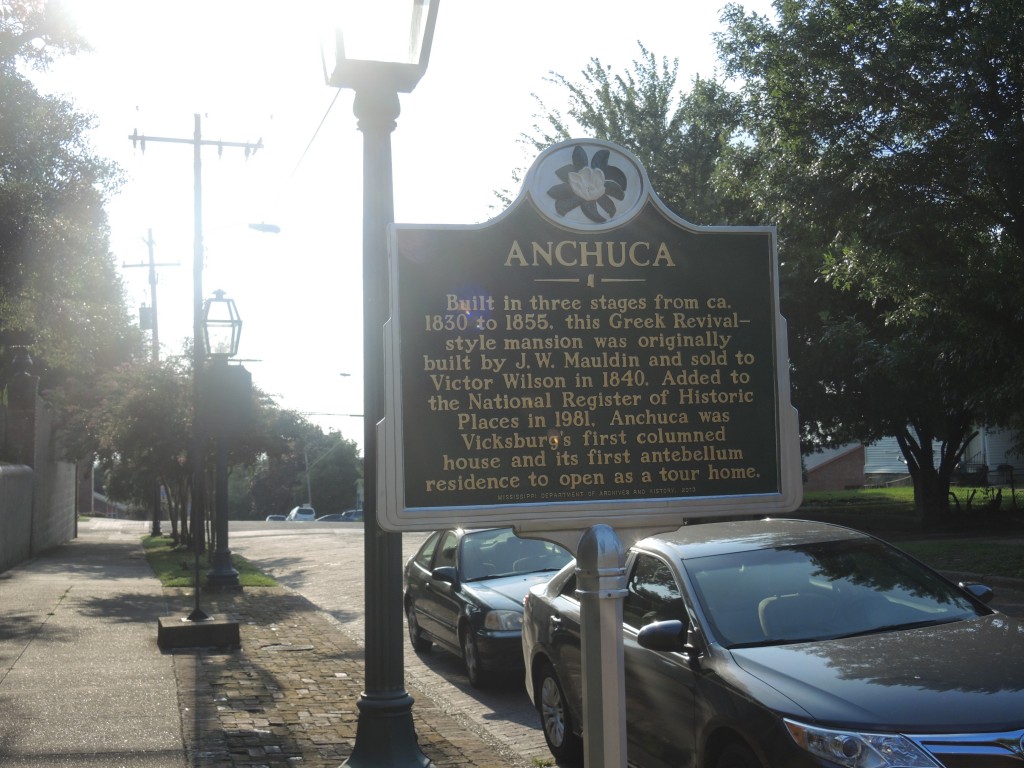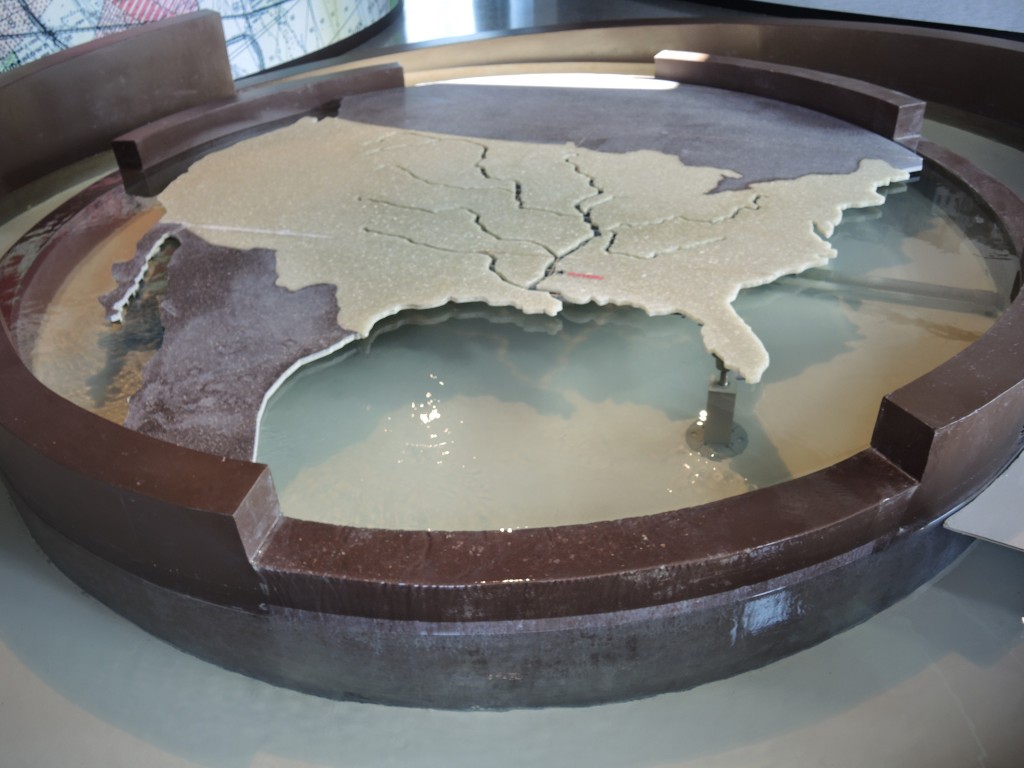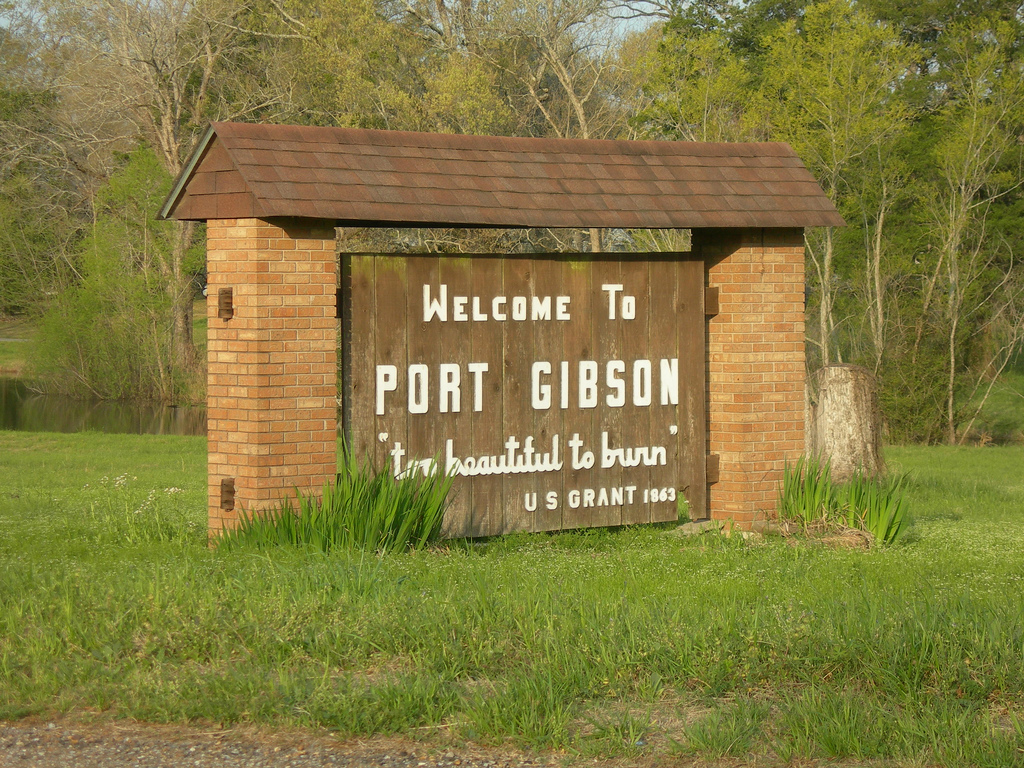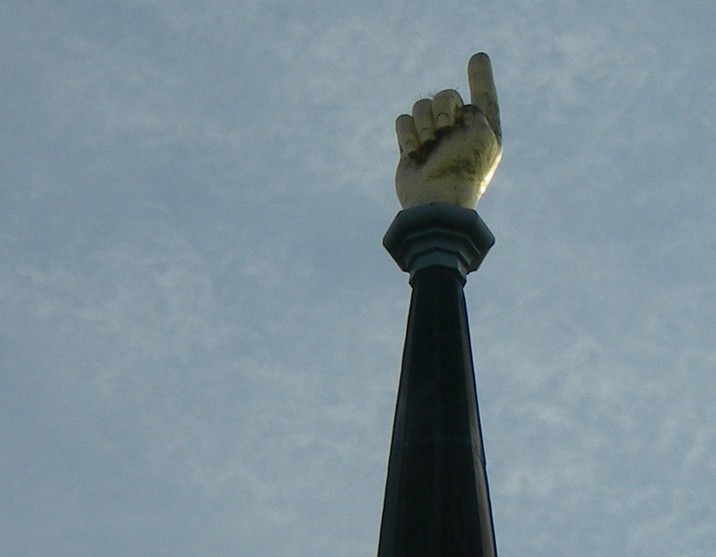I ended my previous entry with a hint that my accommodations in Vicksburg would be qualitatively different from the Shack Up Inn and I’m sure all my loyal readers have been nervously awaiting the resolution of this cliffhanger. (Sorry, I know of no sarcasm font in Word Press.) Still, among the particulars Anchuca in Vicksburg has that the Shack Up Inn lacks, is a historical marker in front of the property.¬† Needless to say, Anchuca is a tad more upscale than the Shack Up.
Needless to say, Anchuca is a tad more upscale than the Shack Up.
The town of Vicksburg sits at the confluence of the Yazoo and Mississippi Rivers in the Capital/River Region of the state so technically my night in Vicksburg was my first in Mississippi outside the Delta Region. When I arrived there late Monday afternoon, I checked into the Inn and decided to have a bit of a stroll before dinner. While sections of the city abut the rivers, much of the town sits on bluffs on the eastern side of the Mississippi. The hills are surprisingly steep and the “stroll”, while enlightening, proved a bit more strenuous than I anticipated.
I walked mostly downhill to the riverside and discovered that, in addition to being just blocks from the G R R, Anchuca was also close to the two main sites I’d targeted as places to see and visit before leaving Vicksburg sometime Tuesday morning. These were the levee murals and the Lower Mississippi River Museum.
Those of you familiar with American history likely know that the Confederates surrendered at Vicksburg on 4 July 1863 ending a 47-day siege that began on 18 May. When coupled with Robert E Lee’s surrender at Gettysburg the previous day, these events are considered the turning point of the American Civil War. While of significantly shorter duration than the 10-month long siege of Petersburg, the battle for Vicksburg, lasting just a day less than the Siege of Port Hudson (Louisiana), is considered the second longest battle of the war.
Those of you familiar with me might wonder why I would choose to eschew visiting either the National Battlefield of the site that Confederate President Jefferson Davis called “the nail head that holds the South’s two halves together” or the National Cemetery where over 17,000 Union soldiers are interred and is the largest such cemetery in the country. (About 5,000 Confederate soldiers originally buried behind Confederate lines have been re-interred in the Vicksburg City Cemetery in an area called “Soldiers’ Rest.”) The answer is, I think, living my entire life in the mid-Atlantic region with my exposure to Gettysburg, Antietam, Manassas (Bull Run), and other Civil War sites in close proximity to me, has saturated any deep interest in other Civil War sites regardless of their historic importance.
Though the overall duration of my walk was fairly brief, the day was warm and the uphill return walk demanding enough that I showered and had a brief rest before dinner. According to Trip Advisor, the Cafe at Anchuca is the top-rated place to eat in Vicksburg. So I saw no need to go anywhere else. The meal was satisfactory – I had a salad with grilled chicken (dry breast meat again!) and drank water because the beer list was limited to mostly domestic bottled beers with no local brews.
One of the first things I spotted in my walk around Vicksburg Monday afternoon was another Blues Trail Marker so, of course, I snapped a photo. But I shot the other photos in the album Tuesday morning with my focus on the levee murals. From here, it was literally steps to the Lower Mississippi River Museum where I’d parked for the morning.
From here, it was literally steps to the Lower Mississippi River Museum where I’d parked for the morning.
Living in metropolitan Washington, DC, where the Smithsonian is free, I always face a brief period of adjustment having to pay admission fees to museums when I travel but always settle in to altered expectations after a day or two. So, you can imagine my surprise when I entered this museum and discovered that it was free. In addition to its being a bargain at twice the price, I will say that, since the exhibits and many of the displays are interactive, people with children will find it a good place to spend some time. After walking by the fountain pool  you enter the museum’s orientation theater where a seven-minute film runs continuously. It describes life on the river as well as the work of the US Army Corps of Engineers and the Mississippi River Commission. In the course of its brief running time, the narrator must make reference to the “Mighty Mississippi” a half dozen times and this motif repeated throughout.
you enter the museum’s orientation theater where a seven-minute film runs continuously. It describes life on the river as well as the work of the US Army Corps of Engineers and the Mississippi River Commission. In the course of its brief running time, the narrator must make reference to the “Mighty Mississippi” a half dozen times and this motif repeated throughout.
As I progressed through the exhibits, noting that one after another focused on controlling and managing the river, I came to realize that the museum is a paean to the work of the Corps of Engineers and the Mississippi River Commission. When I picked up the museum’s brochure, I saw that it was stamped with the insignia of the Corps. Given its connection with that federal agency and, that the museum is in some ways a facility that promotes the work of the Corps of Engineers, it clarified the reason for the lack of an admission fee.
From Vicksburg it would be a straight shot of about 30 miles down one of the Highway 61 segments of the G R R to Port Gibson. Among the characteristics that make Port Gibson a noteworthy place to visit in Mississippi is one it shares with Savannah, Georgia. Just as General William T Sherman declined to burn Savannah (though likely for strategic reasons) on his march to the sea, General Ulysses S Grant declined to burn Port Gibson as he marched through Mississippi toward the Siege of Vicksburg. However, Grant left the town intact because, as he said and as the sign points out when you enter, it was “too beautiful to burn.”
 Many of the pre-Civil War buildings remain intact to this day and I’m certain that visitors who are charmed by this aspect of a place would find Port Gibson charming. Those of you who remember my reactions in Elsah know that I am not that sort of visitor. Rather, I came to Port Gibson seeking two buildings in particular.
Many of the pre-Civil War buildings remain intact to this day and I’m certain that visitors who are charmed by this aspect of a place would find Port Gibson charming. Those of you who remember my reactions in Elsah know that I am not that sort of visitor. Rather, I came to Port Gibson seeking two buildings in particular.
The first was a church. Originally founded as the Bethel Presbyterian Church in Bayou Pierre in 1824 the church moved to Port Gibson sometime soon afterward. In 1828, it officially became the First Presbyterian Church of Port Gibson. So, why would I, of all people want to see a church? Well, the building has a feature unique enough to merit a mention as a worthy roadside attraction on roadsideameirca. Colloquially, the church is known as the “Finger Pointing to Heaven Church.” This picture shows why.
But there is yet one other notable religious building in Port Gibson. This would be Temple Gemiluth Chessed just a block or so farther along Church Street. The temple was built in a Moorish Revival style in 1892 by a community of immigrants from Alsace-Lorraine and it’s the oldest surviving synagogue in Mississippi. This interested me not only as a Jew (as irreligious as I may be) but also because I have ancestors through my maternal grandmother from Alsace-Lorraine. The Jewish congregation disbanded in the mid-1980s and the building is now used by a Messianic congregation.
After snapping a photo of a Blues Trail Marker, I headed off by a circuitous route for Windsor Ruins.  Read about that and more in the next post.
